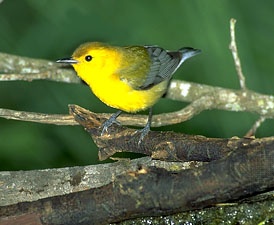wood warbler
bird
 any of about 120 species in the songbird subfamily Parulinae (Parulidae), within the huge family Emberizidae. Wood warblers are New World birds (bird), distinct from the true warblers (warbler) of the Old World (family Sylviidae). Because most wood warblers are brightly coloured and active, they are known as the “butterflies of the bird world.” The more than 50 North American species of wood warbler are highly migratory, flying from northern forest nesting grounds to tropical wintering grounds. This long-distance migration both poses a plight and offers a spectacle. Because of deforestation in South America, populations of many of these birds are declining. But during the northward migration in spring, it is possible in some areas in the eastern United States to see 30 different species of warbler in a day. Despite their name, they do not warble but sing in thin, dry, sometimes buzzing voices.
any of about 120 species in the songbird subfamily Parulinae (Parulidae), within the huge family Emberizidae. Wood warblers are New World birds (bird), distinct from the true warblers (warbler) of the Old World (family Sylviidae). Because most wood warblers are brightly coloured and active, they are known as the “butterflies of the bird world.” The more than 50 North American species of wood warbler are highly migratory, flying from northern forest nesting grounds to tropical wintering grounds. This long-distance migration both poses a plight and offers a spectacle. Because of deforestation in South America, populations of many of these birds are declining. But during the northward migration in spring, it is possible in some areas in the eastern United States to see 30 different species of warbler in a day. Despite their name, they do not warble but sing in thin, dry, sometimes buzzing voices.Their usual nest is a tidy cup in a bush or a tree; some (e.g., the ovenbird) make a domed nest on or near the ground. Wood warblers lay two to five (rarely six) speckled eggs (egg).
The best known is the yellow warbler (Dendroica petechia), sometimes miscalled the wild canary, which breeds from Alaska and Newfoundland to the West Indies, Peru, and the Galapagos Islands; it is 13 cm (5 inches) long, and the males have faintly red-streaked underparts. Dendroica is the largest genus of wood warblers; this chiefly North American genus has 27 species, most of which have contrasting plumage, such as the black, white, and yellow of the myrtle warbler (D. coronata). A common but less-striking species is the blackpoll warbler (D. striata). Some authors merge Dendroica in Vermivora, a less-colourful genus of 11 species, most of them well known in the United States.
The family's namesake, the northern, or American, parula warbler (Parula americana), which breeds in eastern North America, is pale blue, with white wing bars, a partial white eye ring, and a yellow breast crossed by a narrow dark band. The black-and-white warbler (Mniotilta varia), common east of the Rockies, is streaked and has creeperlike habits. A large tropical genus is Basileuterus; the 22 species are typified by the golden-crowned warbler (B. culicivorus), which is found from Mexico to Argentina.
The yellowthroats, any of the eight species of the genus Geothlypis, live in marshes and wet thickets. The male of the common yellowthroat (G. trichas)—often called the Maryland yellowthroat in the United States—is yellow with a black mask; his song, a strong repeated “wicheree,” is heard from Alaska and Newfoundland to Mexico. Other yellowthroat species are resident in the tropics. (For other wood warblers, see chat and redstart.)
- Moore, Sir John
- Moore, Stanford
- Moore, Thomas
- Moorhead
- moorhen
- Moorish idol
- Moorish Science Temple of America
- moose
- Moose Factory
- Moosehead Lake
- Moose Jaw
- Moose River
- Moosonee
- mopoke
- Mopti
- Moquegua
- Moraceae
- Moradabad
- moraine
- Morais, Vinícius de
- Morales Bermúdez, Francisco
- Morales, Cristóbal de
- Morales, Evo
- Morales, Luis de
- morality play